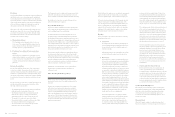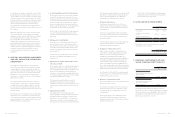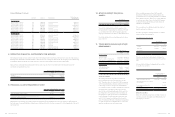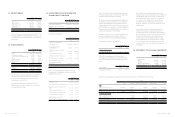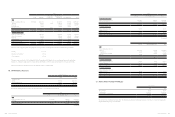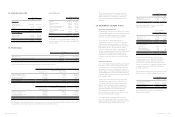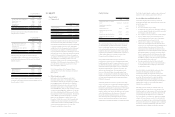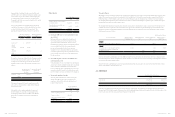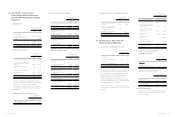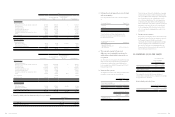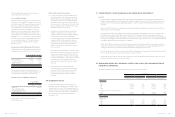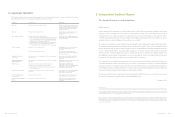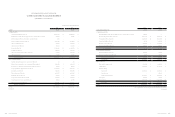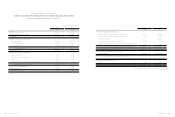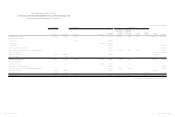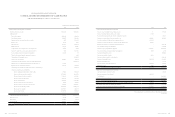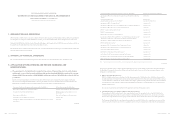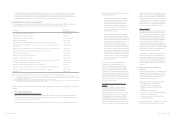HTC 2014 Annual Report Download - page 109
Download and view the complete annual report
Please find page 109 of the 2014 HTC annual report below. You can navigate through the pages in the report by either clicking on the pages listed below, or by using the keyword search tool below to find specific information within the annual report.
• Financial information Financial information •
214 215
Shares
Unit: In Thousands of Shares
For the Year Ended December 31
2014 2013
Weighted average number of ordinary shares used in computation of basic earnings (loss) per share
Effect of dilutive potential ordinary shares:
Bonus issue to employees
824,194
622
829,082
-
Weighted average number of ordinary shares used in the computation of diluted earnings (loss) per share 824,816 829,082
If the Company was able to settle the bonuses paid to employees by cash or shares, the Company presumed that the entire amount of the
bonus would be settled in shares and the resulting potential shares were included in the weighted average number of shares outstanding
used in the computation of diluted earnings per share, if the effect is dilutive. Such dilutive effect of the potential shares was included
in the computation of diluted earnings per share until the shareholders resolve the number of shares to be distributed to employees at
their meeting in the following year.
26. SHARE-BASED PAYMENT ARRANGEMENTS
Employee Share Option Plan of the Company
Qualified employees of the Company and its subsidiaries were granted 15,000 thousand options in November 2013. Each option entitles
the holder to subscribe for one common share of the Company. The options granted are valid for 7 years and exercisable at certain
percentages after the second anniversary from the grant date.
Qualified employees of the Company and its subsidiaries were granted 19,000 thousand options in October 2014. Each option entitles
the holder to subscribe for one common share of the Company. The options granted are valid for 10 years and exercisable at certain
percentages after the second anniversary from the grant date.
The exercise price equals to the closing price of the Company’s common shares on the grant date. For any subsequent changes in the
Company’s common shares, the exercise price is adjusted accordingly.
Information on employee share options were as follows:
For the Year Ended December 31
2014 2013
Number of
Options
(In Thousands)
Weighted-average
Exercise Price
(NT$)
Number of
Options
(In Thousands)
Weighted-average
Exercise Price
(NT$)
Balance at January 1
Options granted
Options forfeited
15,000
19,000
(2,092)
$149.0
134.5
-
15,000
-
$-
149.0
Balance at December 31 31,908 15,000
Options exercisable, end of the year - -
Weighted-average fair value of options granted per unit (NT$) $31.231 $43.603
Information about outstanding options as of the reporting
date were as follows:
December 31
2014 2013
Range of exercise price (NT$) $134.5-$149 $149
Weighted-average remaining
contractual life (years)
8.22 years
6.8 years
Options granted in October 2014 and November 2013 were
priced using the trinomial option pricing model and the
inputs to the model were as follows:
October 2014 November 2013
Grant-date share price (NT$) $134.5 $149
Exercise price (NT$) 134.5 149
Expected volatility 33.46% 45.83%
Expected life (years) 10 years 7 years
Expected dividend yield 4.40% 5.00%
Risk-free interest rate 1.7021% 1.63%
Expected volatility was based on the historical share price
volatility over the past 1 year. The Company assumed that
employees would exercise their options after the vesting
date when the share price was 1.63 times the exercise price.
Employee Restricted Shares
In the shareholder meeting on June 19, 2014, the
shareholders approved a restricted stock plan for employees
with a total amount of $50,000 thousand, consisting of 5,000
thousand shares. On October 31, 2014, the Company’s board
of directors passed a resolution to issue 4,600 thousand
shares.
The restrictions on the rights of the employees who acquire
the restricted shares but have not met the vesting conditions
are as follows:
a. The employees cannot sell, pledge, transfer, donate or in
any other way dispose of these shares.
b. The employees holding these shares are entitled to
receive cash and dividends in share.
c. The employees holding these shares have no voting
rights.
If an employee fails to meet the vesting conditions, the
Company will recall or buy back and cancel the restricted
shares.
Information about outstanding employee restricted shares
as of December 31, 2014 was as follows:
Grant-date November 2, 2014
Grant-date fair value (NT$) $134.5
Exercise price Gratuitous
Numbers of shares (thousand shares) 4,600
Vesting period (years) 1-3 years
Compensation Cost of Share-based Payment
Arrangements
Compensation cost of share-based payment arrangement
were recognized NT$244,346 thousand and NT$23,443
thousand for the years ended December 31, 2014 and 2013,
respectively.
27. CAPITAL MANAGEMENT
The Company manages its capital to ensure its ability to
continue as a going concern while maximizing the returns to
shareholders. The Company periodically reviews its capital
structure by taking into consideration macroeconomic
conditions, prevailing interest rate, and adequacy of cash
flows generated from operations; as the situation would
allow, the Company pays dividends, issues new shares,
repurchases shares, issues new debt, and redeems debt.
The Company is not subject to any externally imposed
capital requirements.
28. FINANCIAL INSTRUMENTS
Fair Value of Financial Instruments
a. Financial instruments not carried at fair
value
Financial instruments not carried at fair value held by
the Company include financial assets measured at cost.
The management considers that the carrying amounts
of financial assets and financial liabilities not carried at
fair value approximate their fair value or the fair value
are not measured reliably.
b. Fair value measurements recognized in the
parent company only balance sheet.
The following table provides an analysis of financial
instruments that are measured subsequent to initial
recognition at fair value, grouped into Levels 1 to 3 based
on the degree to which the fair value is observable:


